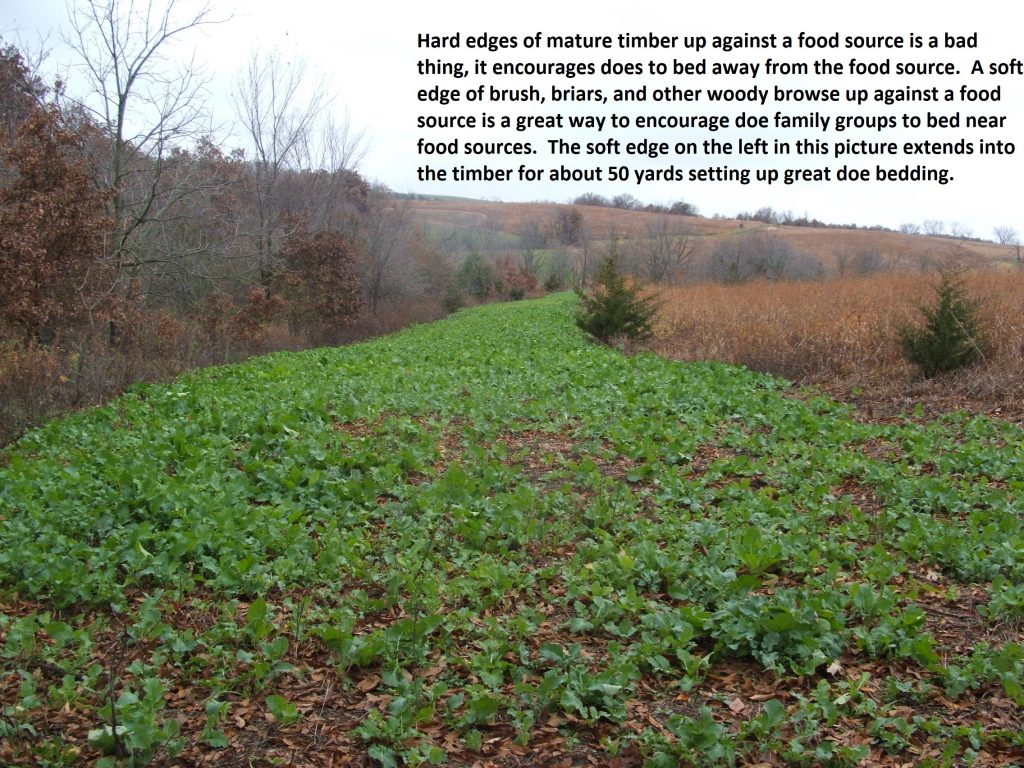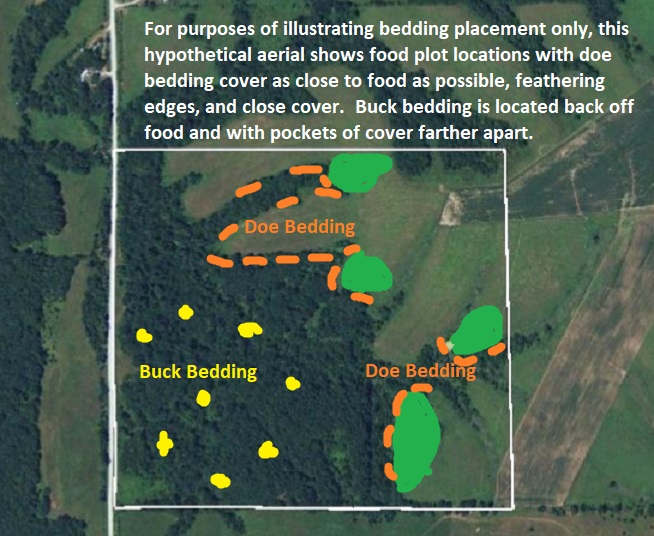When I was a teenager, the farm I hunted exclusively was my grandpa’s 120 acres. It was filled with mature maples, oaks, and poplar. There was very little undergrowth, woody browse, or bedding cover. The thing is, I didn’t know it. I had no idea that the habitat was terrible and really wouldn’t hold deer. It was common to talk with neighbors who would see deer on a consistent basis, when we really couldn’t. All the deer we saw seemed to come from the neighbors, travel through my grandpa’s farm, and then exit.
We had other issues too like hunting pressure, and the fact that we hunted small game on the farm relentlessly. But as I grew older and started hunting other properties, it became obvious that the over-arching issue was a lack of cover and daytime browse. My father, who acquired the farm when my grandpa passed, enrolled the farm in a conservation plan that included aggressive timber harvests over the next 15 years. With each timber harvest, a spike of new growth came. Young aspen, oak, and maple replaced the open woods. Pockets of briars and woody browse also popped up all over. And with that, the deer came back and started spending time on the farm. Our hunting got much better, and we started seeing deer with regularity.
Thirty years ago, our attempt at improving the habitat was really to just clear-cut large swaths of timber. It was more a way to maximize timber value than to create good cover with any sort of purpose. It did work, but with severe limitations. Nothing was planned and the cover was made indiscriminately. There was no reason other than to maximize timber profits with a residual of having better habitat. Today, I know there is a much better way to go about it for whitetail hunters.
Creating Doe Bedding Cover
Everyone’s always wanting to create bedding cover for bucks. Just type in buck beds or buck bedding in YouTube and you’ll get plenty of hits. The problem is, you can’t have good buck security areas and bedding cover without first providing bedding cover for doe family groups. Why? Because bucks, especially mature bucks, don’t like to bed with doe family groups. They don’t like the stress and activity that occurs in and around doe and fawn groups. I’m not saying you’ll never see mature bucks bedding near does, but that is the exception and it is not what they prefer.
The best place to locate doe bedding is as close to preferred fall food sources as you can. Doe family groups want to bed next to food, so if you give them the option of doing so that’s where they’ll likely set up their daytime bedding. This could be directly adjacent to a quality fall food source, or it could mean a few hundred yards away in the closest cover area there is. The closer the better. Does and fawns will also tolerate quite a bit of social stress and activity in and around their bedding areas. So, it is much easier to stack a bunch of does and fawns in and around food in closer quarters.
It is important when you are planning on where to create doe bedding that you try to locate this bedding cover as close to food as you can. The first reason is because that is where they prefer to be, but the second and maybe more important reason is because bucks would rather not be in and around high social stress areas and larger numbers of deer. If you locate doe bedding without taking this into account, you can actually run out of room and acreage when it comes to trying to create security cover for bucks. Think of it like this…deer don’t have tape measures but bucks would prefer to bed say 200 to 300 yards from doe family groups if they can. In many mixed agriculture settings, there are many scenarios where you can’t or don’t have that kind of distance from food to cover. Therefore, you need to concentrate making security cover areas as close to food as you can so that you still have space for bucks to bed. If not, they may bed entirely off your property most of the year.

Stacking Them In
As described already, doe family groups will tolerate stress from each other. So, when you are creating doe bedding, you are able to create pockets of cover that is much closer together. As long as deer are able to move freely in and around the cover, you almost can’t make it too thick. A great way to create this cover next to food is by creating a soft edge where timber meats agriculture. We’ve all seen mature timber right up against a food plot or agriculture setting…by simply cutting back or hinge cutting along this hard edge and “feathering” it so that it goes from food, to brush and briars, to mature timber will accomplish this. If I have a long line of hard edge, what also works really well is to create this feathering affect along its entire edge with small sections of mature timber remaining. This allows for easy entry and exit into the food source by the doe groups. You can also edge feather around smaller food plots, along timbered draws, or anywhere else you can put doe bedding next to food.
To create doe bedding cover in larger fields of warm season grasses (like CRP), simply create strips or pockets of briars, weeds, or young early sapling growth within the grass stand. The easiest way to do this is to disc or spray to set the grasses back in those areas allowing broadleaf weeds, briars, or small saplings to grow. Several back to back years of spraying a grass specific herbicide works great.
It is important to consider how you will be accessing your land for hunting. Where you need to walk. How you will be hunting transition areas. The last thing you want to do is locate a bunch of bedding cover where you need to walk each day during hunting season.
Creating Buck Bedding
As already described, bucks don’t prefer to bed in and around a bunch of does and fawns. Ideally, I think if does like it right on top of food, bucks would prefer 200 to maybe 600 yards away from food and doe family units. Not all properties have 600 yards of space between cover and food, but to consistently hold bigger deer you need to allow some space. If you can provide bedding cover 200 plus yards away from the does (which are at the food right) you’ll be able to layer the does and bucks in on your land. Think food, doe bedding right on top of food, then buck bedding at least 200 yards beyond that if you can.
In hilly or bluff country, all deer prefer to bed high if they can. But, layering of doe bedding and buck bedding still applies with does closer to food, while bucks are farther “back in” away from food and the doe family units.
Pocket Bedding for Bucks
Unlike does, buck bedding should not be made so that bucks are stacked up next to each other. Instead of making big cuts or lines of bedding, my favorite way to create great buck bedding is in pockets. That could be three or four trees hinge cut in a circle, maybe it’s one big willow tree hinge cut into a marsh, or several trees hinged out into tall warm season grasses along a CRP field. The point is, spread out the cover. Some of the biggest bucks I’ve ever killed routinely bedded in areas that were not even thick…but they were away from human activity and away from doe family groups and simply used a fallen tree, or terrain features to give them the cover they wanted. Location and proximity to where the does are bedding is key. When I’m creating these buck pockets of cover, I’m spreading them out so that the pockets are 50 or even 100 yards apart.
And, just like with doe bedding, plan ahead to how you will hunt after the bedding is created. Remember you access points so that you aren’t having to walk by bedding areas. Try to think “it would be easy to hunt bucks on a bed to feed pattern if they bedded here”. Or “it would be easy to hunt bucks returning to their beds if they bedded here”. There’s no sense in creating good bedding cover if you can’t hunt it.
January is great for creating bedding cover. Before you drop or hinge a single tree, plan out your attack. Remember to start with doe bedding around evening food sources, and then offering bucks the space they want before creating buck bedding. Properties that are laid out this way will attract and hold more deer and big bucks than those that aren’t.

